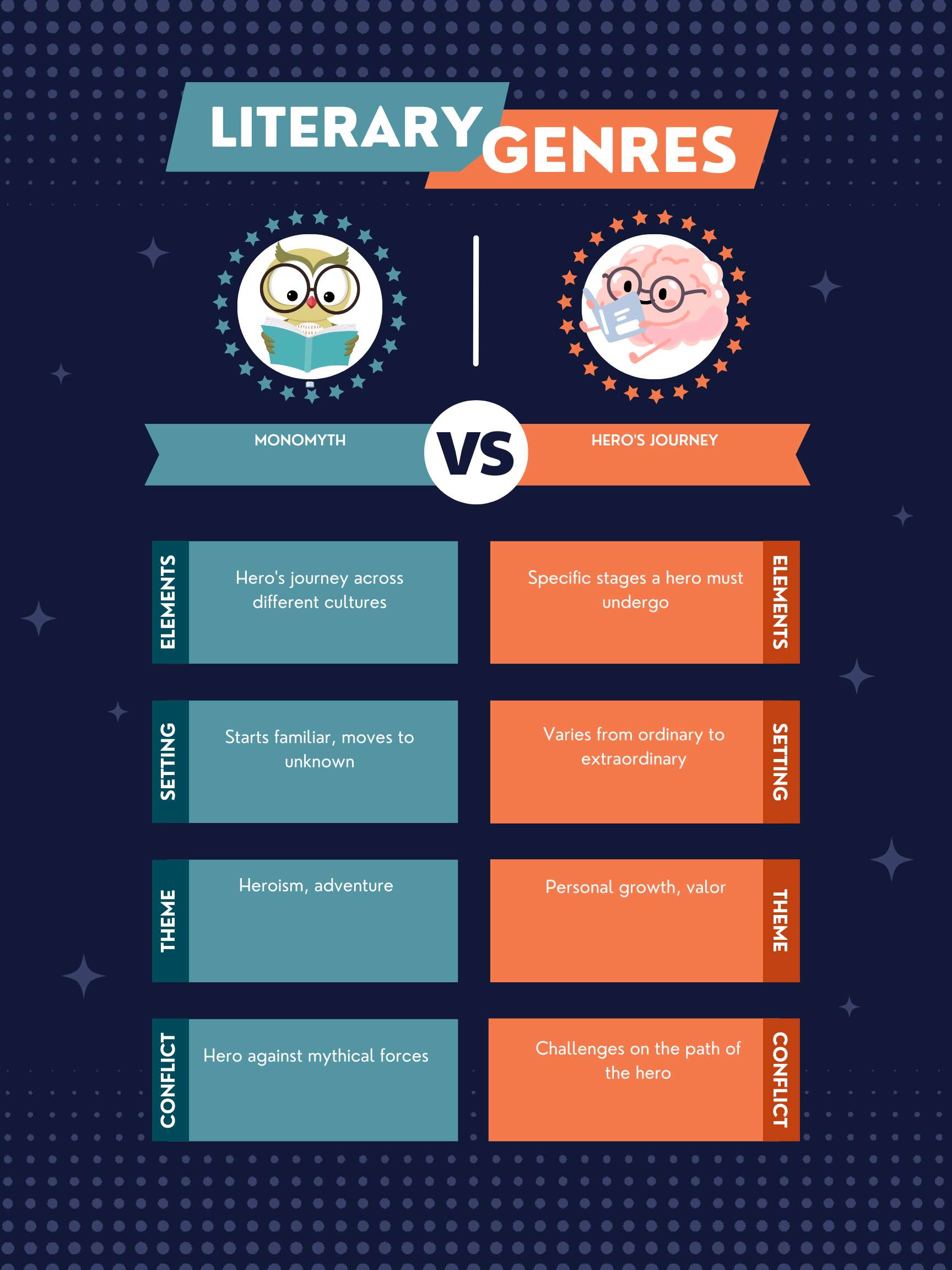Monomyth, or the Hero’s Journey, refers specifically to Joseph Campbell’s narrative pattern found in many stories worldwide, describing a hero’s adventure and transformation; while they refer to the same concept, “Hero’s Journey” is more commonly applied to individual stories.
Monomyth
The Monomyth, a term coined by Joseph Campbell in his work The Hero with a Thousand Faces, outlines a universal pattern that many mythical heroes across various cultures follow. This pattern includes stages like the Call to Adventure, the Initiation, and the Return. Campbell argues that this pattern is universal, evident in myths from around the world.
Example: The story of Buddha fits the Monomyth pattern, where Siddhartha Gautama leaves his royal life (Departure), seeks enlightenment (Initiation), and returns to teach others (Return).
Hero’s Journey
The Hero’s Journey, while based on Campbell’s Monomyth, is often used to describe the specific journey of a hero within a single story. It is a narrative device that divides the hero’s journey into distinct phases, making it a useful tool for writers to structure their narratives.
Example: In Star Wars, Luke Skywalker’s journey from a farm boy on Tatooine to a Jedi Knight reflects the Hero’s Journey, including his initial call to adventure, confrontation with and triumph over Darth Vader, and return as a hero.
Summary
| Literary Device | Definition | Purpose | Usage | Relevant Examples |
|---|---|---|---|---|
| Monomyth | A universal narrative pattern outlining a hero’s journey, identified by Joseph Campbell. | To highlight the universal aspects of the human experience through the hero’s adventure. | Used to analyze myths and stories from various cultures to uncover common themes. | The story of Buddha. |
| Hero’s Journey | A narrative device that structures a story around the phases of the hero’s adventure, based on Campbell’s Monomyth. | To provide a framework for storytelling, emphasizing the hero’s growth and transformation. | Applied in crafting individual stories, guiding the development of the protagonist’s character arc. | Star Wars saga. |
Writing Tips
For writers intrigued by the Monomyth or Hero’s Journey, here’s how to weave these patterns into your narratives:
- Reflect on the Universal Themes: Consider how your story connects with universal themes like the battle between good and evil, the quest for self-discovery, or the journey towards enlightenment.
- Structure Your Hero’s Journey: Use the stages of the Hero’s Journey as milestones in your story, ensuring your hero encounters trials, allies, enemies, and a final confrontation that leads to transformation.
- Personalize the Journey: While following the established pattern, infuse your hero’s journey with unique challenges, settings, and characters that reflect your story’s world and your hero’s personality.
FAQs
Are Monomyth and Hero’s Journey the same?
They are closely related concepts with the Monomyth providing the theoretical framework, and the Hero’s Journey being the practical application in storytelling.
Can a story follow the Hero’s Journey without including all stages?
Yes, while many stories follow the general outline, they can vary in how many stages they include and how those stages are presented.
How can I make my Hero’s Journey unique?
Focus on creating unique challenges, diverse characters, and a setting that differentiates your hero’s journey from others. Personalization is key to standing out.
Exercise
Identify whether the following description fits the Monomyth or Hero’s Journey:
- An analysis of the thematic similarities between ancient Greek myths and modern superhero stories.
- A fantasy novel where the protagonist leaves their village to defeat a dark lord, learning valuable lessons and gaining allies along the way.
Answers:
- Monomyth.
- Hero’s Journey.
Other Device Comparisons You May Find Interesting
- First-Person vs Third-Person Narration: Explore the impact of narrative perspective on storytelling.
- Static vs Dynamic Characters: Understand the differences between characters who undergo significant development and those who do not.
- Plot vs Theme: Delve into how the storyline and underlying messages contribute to a narrative.
- Symbolism vs Motif: Discover how recurring symbols and motifs add depth and layers of meaning to a story.
Embracing the Monomyth or Hero’s Journey can enrich your storytelling, connecting your narrative to the universal patterns that resonate with readers across cultures and ages. 🌍✨

